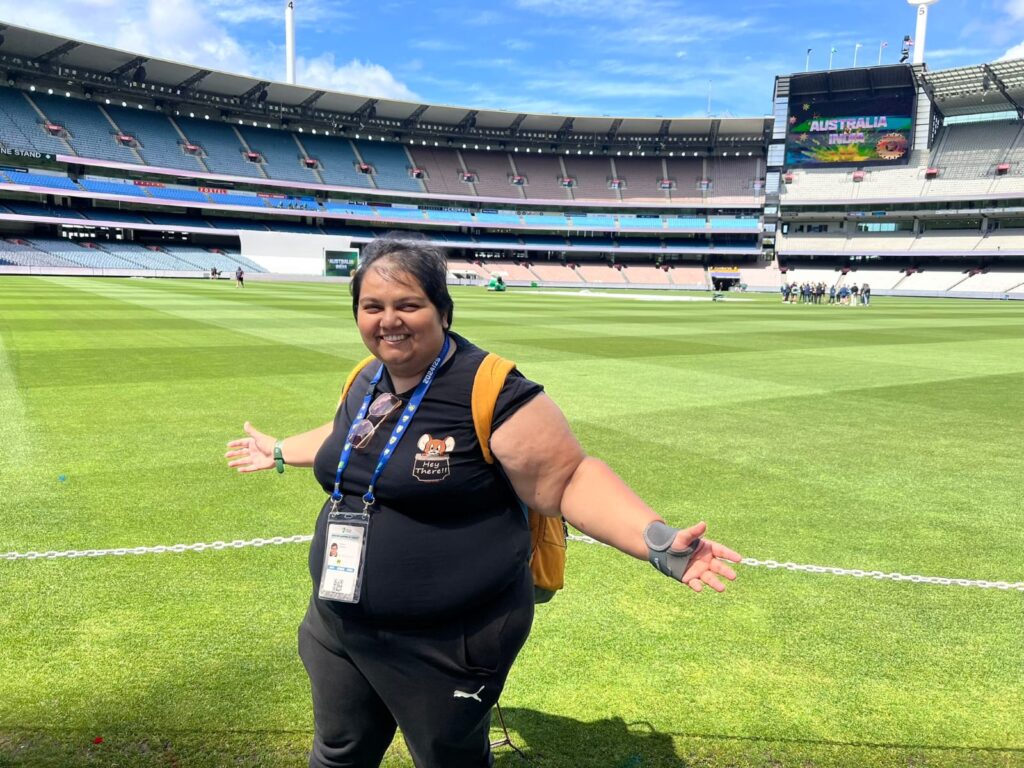
By Trisha Ghosal in Sydney
The Unseen Struggle of Female Media Professionals in Cricket
Covering cricket is an exhilarating experience—thrilling matches, electrifying crowds, and the privilege of witnessing sporting history unfold. But for women in sports media, the behind-the-scenes reality often includes challenges that should have been resolved long ago, one of the most glaring being the state of basic facilities, particularly toilets.
During the recent cricket season, I had the privilege of covering matches at the Melbourne Cricket Ground (MCG) and the Sydney Cricket Ground (SCG). Both venues exemplify what world-class facilities should look like—not just for players and broadcasters but for spectators as well. The audience toilets at these Australian venues were so clean and well-maintained that I didn’t think twice about using them. Aisha Gooptu Majumdar, daughter of our editor Boria Majumdar, could even change her sanitary napkin in a public restroom without hesitation—a testament to the hygiene standards.
Contrast this with the grim reality back home in India. At most Indian stadiums, the story is drastically different. By the end of the first session of play, the toilets are often unfit for use—littered, stinking, and devoid of water or basic amenities like dustbins for sanitary napkin disposal.
A Personal Tale: The Kotla Predicament
One incident that will forever be etched in my memory took place at the Feroz Shah Kotla during the Duleep Trophy. As a broadcaster, I was tasked with managing graphics for the live telecast. Unfortunately, I developed food poisoning mid-match, which meant I needed frequent trips to the restroom.
Here’s the catch: there were no separate toilets for broadcasters. The closest option was the men’s restroom, while the women’s restroom was a staggering 500 meters away from the Production Control Room (PCR). In live broadcasting, where every second matters, making the trek to the women’s restroom felt like a marathon. Combine that with the urgency caused by food poisoning, and the ordeal became almost unbearable.
What’s more disheartening is that these women’s restrooms were not just far but also poorly maintained. The lack of cleanliness and basic amenities made an already difficult situation exponentially worse.

Menstrual Health and Public Restrooms: A Basic Human Need
For women, menstrual health adds another layer of complexity to this issue. Changing a sanitary napkin or managing menstrual hygiene in unclean, inaccessible restrooms is not just inconvenient—it’s degrading. In a country like India, where women are increasingly breaking barriers in sports and media, it is shocking that we still have to fight for such fundamental necessities.
In stark contrast, my experience in Australia underscored how far Indian stadiums have to go. At the SCG, I didn’t even have to think about restroom hygiene—it was a given. The audience toilets were equipped with dustbins, ample water supply, and were cleaned regularly. This difference isn’t just about comfort; it’s about dignity and respect for everyone who steps into the stadium.
The Role of State Cricket Associations
The responsibility for this change lies squarely with state cricket associations, which manage the infrastructure at Indian stadiums. While a lot of focus is placed on pitch preparation, media rooms, and hospitality for players, the condition of public restrooms—let alone those meant for media personnel—often remains an afterthought.
State associations must realise that clean, accessible toilets are not a luxury but a basic requirement for everyone in the stadium, including spectators, journalists, and staff. Investing in proper maintenance, installing separate restrooms for media personnel, and ensuring regular cleaning schedules should be non-negotiable.
A Call for Change
As more women enter sports media, it is imperative to address these infrastructural gaps. Clean and hygienic toilets are not just about physical comfort—they affect our mental well-being, productivity, and ability to perform under pressure.
Countries like Australia have set a benchmark that India can and should emulate. With the rise of world-class cricketing venues like Ahmedabad’s Narendra Modi Stadium, there is hope for improvement. But the change needs to trickle down to every stadium, big or small.
For a nation that prides itself on its cricketing heritage and growing stature in world cricket, it’s high time we matched those accolades with facilities that reflect the same level of excellence.
Cricket may be India’s religion, but even religions demand sanctity. Clean and accessible restrooms are not an unreasonable ask—they are a reflection of how much we value the people who make the sport possible, from players to fans to the media.
As a female sports journalist, I’ve navigated through these challenges because of my passion for the game. But passion alone shouldn’t have to carry us through situations that can be easily fixed. It’s time for state associations to step up and ensure that no woman—whether a journalist, broadcaster, or fan—has to think twice before using a toilet at a cricket stadium in India.



